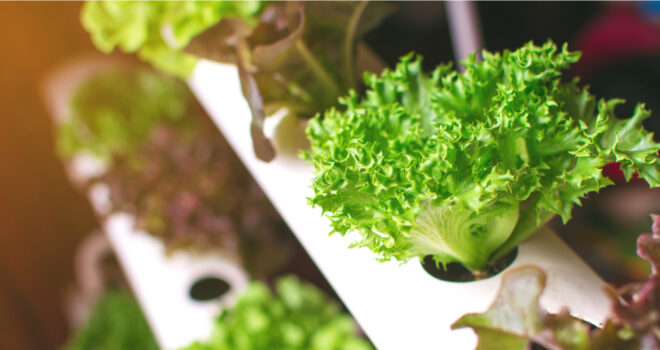Soilless farming systems, i.e., hydroponics, aquaponics and aeroponics, have many advantages that are bound to appeal to farmers, agronomists and consumers. A quick overview of these systems.
Certain forms of horticulture, unlike in-ground crops, are soilless. These systems can be used to grow plants at home, as well as on a more commercial scale, and are suitable for various vegetables (leafy vegetables, tomatoes, etc.), fruit (mainly strawberries), aromatic herbs and ornamental plants.
Three methods
In hydroponics, the plants grow on a neutral, solid and inert substrate. This can include materials such as clay balls, sand or even rockwool. A nutrient-enriched aqueous solution provides the plants with the water, oxygen and minerals they need to grow.
Aeroponics is different from hydroponics in that it uses no substrate. The nutrient solution is permanently and directly sprayed onto the plants’ roots.
You don’t need a large space for these techniques and the infrastructure is relatively light (geotextile pots, bags, gutters etc.). That is why these methods work so well in urban spaces, including in gardens, on roofs, on balconies and façades.
Aquaponics, finally, refers to the combination of hydroponics and aquaculture (fish farming). When combined, these two techniques become complementary, allowing farmers to establish a loop that is almost closed, producing fish and plants.
Benefits of soilless systems
Soilless systems are especially interesting when the arable land is polluted, as is often the case with urban and peri-urban soil. These systems can also be useful in geographical areas where the soil is not fertile or there is no access to soil.
Moreover, these systems require less water than soil-based cultivation, which helps preserve this valuable resource. The installation of such systems is also an option in areas with limited access to water resources.
A third important advantage is that these systems generate a higher yield compared with traditional agriculture. According to the FAO, the vegetable yield of soilless systems is 20 to 25% higher than in traditional systems, because the former confine the roots in smaller spaces, which means the number of plants per square metre is higher.



 Purslane
Purslane  Eggplant
Eggplant  Vegetable garden: growing cauliflower
Vegetable garden: growing cauliflower 









